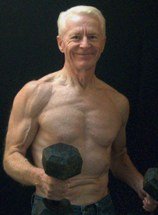
March 1, 2012
What is
Periodization
Training?
In my beginner’s book for seniors, I explain a straight-line progression plan for building strength and fitness. You begin lifting a weight that is manageable without straining for 12 repetitions. At your next training session, you do 13 reps. Then 14 at the following workout and, finally, 15.Now you add 5 to 10 pounds to the bar, go back to doing 12 reps, and begin the progression over again. It works the same way with cardiovascular exercise. Suppose that you choose walking for cardio. At each workout, you add some minutes to your total. That is how classic straight-line strength and fitness progression works. (Note: Double progression training means doing two workouts before adding reps or weight to the bar, also a valid and sometimes useful method.) It is a solid beginner’s plan – for a while. But eventually you hit a wall. Call it what you want, a “sticking point,” a “plateau,” or whatever. The thing is, if you simply try to push through it while doing the same things the same way, you inevitably experience physical or psychological burnout. The great Russian weightlifters realized this long ago and came up with an effective training protocol known as periodization. It works, more or less, like the following:
- For 4 or 5 weeks, they trained with rather light weight weights (light for them anyway), doing 10 to 20 reps per set.
- Then during the next 4 weeks, they did medium reps per set (5 to 6 reps) with heavier weights.
- Finally, they would do low reps ( 2 or 3 per set) with heavy weights for a few weeks, culminating in a competition.
- After the competition, they would take 1 or 2 weeks of “active rest,” doing some kind of non-lifting type of exercise such as running, swimming, or cycling.
Following the active rest period, they would begin another cycle. Most who read this probably aren’t power lifters and may not want to be one. Nevertheless, once you have progressed beyond the strength and fitness beginner stage, almost all training, whether it is for a particular sport or general good health and conditioning, should follow a somewhat similar format of: 1) gradual buildup; 2) peaking; and 3) backing off a bit (active rest). Why? Because no one can continually push to the limit at every workout and make progress. While on the subject, it should be noted that Russian lifters do not train to failure. Total, all-out efforts are reserved for competitions only. Most of us are not in competitions. Still, the principle remains the same. Test your limits once in a while, but trying for a personal best at every workout only leads to dreading your training, to possible injury, and to eventual failure. Once you have passed the beginner stage, my advice is to train with variety. Mix it up. Change your routine. Do high reps for a while. Then switch to medium reps with heavier weights or more resistance. For cardio, push yourself for a period. Point toward a goal. Reach it. Then back off and do something different and with less intensity for a couple of weeks. In the weight room, during all phases, keep your workouts short but focused. Not only will you make greater progress, you will enjoy your training more.
 
You've probably heard about the tremendous benefits of weight training and how you can retain -- or even reclaim -- the attributes of youth . . . Discover the way with . . .
Gray Iron: A Fitness Guide for Senior Men and Women

Newsletter Policy
The Gray Iron Fitness Newsletter is a free publication sent twice monthly to subscribers. The purpose is to provide honest and realistic fitness information for people age 50 and above.
I have never been paid or received compensation of any kind to write a positive review or endorse a product. If I say that I personally use a product or service, it is because I find value in it and have paid for it with my own money.
Like newspapers, magazines and television, this newsletter and my web site contain advertising and marketing links. Naturally, I am compensated for these.
The newsletter and web site provide information to help users establish and maintain a fitness lifestyle. But fitness information is not the same as fitness advice, which is the application of exercise and dietary practices to an individual's specific circumstances. Therefore, always consult with your physician for assurance that fitness information, and your interpretation of it, is appropriate for you. Your comments and questions are always appreciated.
Sincerely,
Logan Franklin
The Gray Iron Fitness Newsletter
www.senior-exercise-central.com
|




